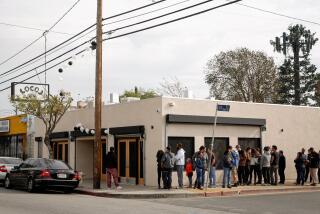Her Carob Treat Venture Will Always Taste Sweet, In Spite of $47,000 in Losses
After four years in business, Bee Williams insisted that her Anaheim Carob Treat store, where she has already lost $47,000 and which she plans to close soon, is a bona fide success.
“Just look at all the people who now know about the carob,” she said, still optimistic that the fruit of the carob will someday generate a successful business for someone.
“I really didn’t think it would go this badly,” she said, although she had a warning: The carob store she once owned in Northern California also closed (“but I didn’t lose as much in that one”).
The Stanton resident said people think the carob--a long, brown, leathery pod that grows on evergreen trees--is a chocolate substitute, which she said caused a lot of her misfortune.
“It doesn’t taste like chocolate,” said Williams, who sells about 220 different products made with the carob, including candy, bread, popcorn and ice cream. “It taste like carob.”
She admitted that the carob takes some getting used to: “It’s an acquired taste. Sometimes it takes people years to like a carob. People that like it, like it.”
Besides saying she may be the world’s foremost expert on the carob, Williams also boasted of having the world’s largest carob library, the result of a long admiration for the fruit, which she said tastes like a cross between a date and honey.
It also has a distinct aroma. “A reporter once wrote that the carob smelled like fertilizer,” she said. “I thought that was a bit much.”
One of her problems, said Williams, a one-time waitress who became a hospital therapist, is that the average person doesn’t know much about the carob, native to the Mediterranean coast.
There are, however, many carob trees growing in Pasadena and about 22,000 of them growing throughout Southern California, she said.
Their numbers have done little for Williams’ business, though.
“I’ve tried, but this store just isn’t working out,” she said. “Sometimes the only person that crosses the threshold all day is the mailman--and he just brings bills.”
Lately, she added, only about 10 customers walk in during an entire week.
But she said she is sure that “if someone with money and an ability to market the carob took this store over, (it) would make money.”
Williams said she plans to travel after the store closes. But she’ll have fond memories of her Anaheim store.
“I love it in here,” she said. “I could have gone completely broke and I would still have enjoyed it. I’ll have known I’ve done something.”
Despite today’s mobile society, there are some folks who stay put, such as the Keiths, the Allees and the Hambys of La Habra.
The three couples just held an open house for neighbors, friends and relatives in the Keith home to celebrate 40 years living in the same house.
In fact, each bought their La Habra homes on South Sunset Street when the only things near the dead-end street “were orange groves and empty fields,” Juanita Hamby recalled. “There were no such things as condominiums then.”
She said just 20 homes were originally built in the subdivision.
A lot of new people have moved into the other houses, she said, “so we thought we’d hold the open house and serve coffee and cake so we could tell everyone about the neighborhood.”
While the three couples--Juanita and Nolan Hamby, Betty and Ray Keith, and Lurline and Art Allee--talked about how La Habra has grown, they also reflected on their street.
“You just can’t imagine how many generations of children can be raised on one street,” Juanita Hamby said.
She said the days following World War II were mainly happy times: “Everybody trusted everyone. We didn’t even lock our doors.”
“It’s been a nice street,” she said.
Acknowledgments--Christine Weiner of San Juan Capistrano, a second-year student at Western State University College of Law in Fullerton, was judged best law school advocate in California after winning the 1988 Roger J. Traynor California Moot Court competition in Sacramento. Besides ranking first in her class, Weiner holds a full-time job and is raising three children.
More to Read
Inside the business of entertainment
The Wide Shot brings you news, analysis and insights on everything from streaming wars to production — and what it all means for the future.
You may occasionally receive promotional content from the Los Angeles Times.










